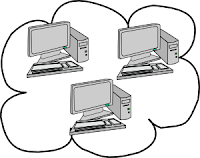 Cloud computing is a model for delivering information technology services hosted over the Internet. These services are broadly divided into three categories: Infrastructure-as-a-Service (IaaS), Platform-as-a-Service (PaaS) and Software-as-a-Service (SaaS). It is called “Cloud Computing” because the information being accessed is found in the "clouds", and does not require a user to be in a specific place to gain access to it.
Cloud computing is a model for delivering information technology services hosted over the Internet. These services are broadly divided into three categories: Infrastructure-as-a-Service (IaaS), Platform-as-a-Service (PaaS) and Software-as-a-Service (SaaS). It is called “Cloud Computing” because the information being accessed is found in the "clouds", and does not require a user to be in a specific place to gain access to it.
What can my organisation achieve with cloud computing?
- Lower total cost of ownership: - Pay only for what you use, as you use it.
- Reduce IT hardware, software, and/or services costs: - By placing all the workloads (hardware, software, services) in the cloud, you would not need to manage all these at your site and thus would reduce capital expenditure investments.
- Reduce data centre facility costs: - Having fewer servers would mean a smaller data center which would result in direct savings on real estate, power, and cooling. A data center may not be required for a public cloud model which offers services to small and medium-size businesses.
- Increased Storage: - A cloud may be able to hold more storage than a personal computer. It takes away the need for the upgrading your own computer memory.
- Mobility: - It allows users to connect even without their own computers, meaning you can do your work from anywhere in the world as long as you have an internet connection and a computer access.
What issues I may face if I move towards Cloud Computing?
- Security: - There is no control over Business Assets (Data) which may have valuable company information. The Physical location of hardware and software is unknown. Site inspections and audits are hard. A recent example of Security Breach is Amazon and Sony Cloud hacking.
- Dependency (Loss of Control): - You may get tied to the financial strength of the other company. You may face Quality problems which you may have no control over.
- Decreased Flexibility: -You would not be able to customize the services you would receive.
- Knowledge: - All the knowledge of the working processes of a Cloud service provider will not be accessible by its users.
- Integration: - Integrating the Cloud services with Printers, local IT equipment etc. may not work.
Which set of business functions can be moved to the cloud?
- IT management and self-service
- Including application development and hosting
- Server infrastructure
- Server virtualization
- Email/messaging
- Team collaboration
Examples of Cloud Computing Services
- (Saas) Google Docs, Salesforce CRM, Microsoft’s Office 365
- (Paas) Google Apps, Social Networking Apps
- RackSpace Cloud Servers, Cloud Files
References
http://searchcloudcomputing.techtarget.com/definition/cloud-computing
http://www.investopedia.com/terms/c/cloud-computing.asp#ixzz1VB7rCYzc
http://www.investopedia.com/terms/c/cloud-computing.asp#ixzz1VB7rCYzc

No comments:
Post a Comment